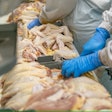
An approach that combines blockchain, artificial intelligence (AI) and the internet of things (IoT) to help improve transparency, efficiency and safety across the entire food chain was named one of the 12 winners of the Food and Drug Administration (FDA) Food Traceability Challenge.
“Eighty to 90% of the producers of our food in America are small farmers who are doing their best to just survive,” Sharmeen Khan, chief marketing officer, OpsSmart Global, explained. “We truly believe that traceability needs to be something that easily accessible and usable – not just cost wise, but also technology wise.”
“In June, we launched the New Era of Smarter Food Safety Low- or No-Cost Tech-enabled Traceability Challenge to encourage the development of traceability solutions that are cost effective for human and animal food operations of all sizes,” Frank Yiannas, Deputy Commissioner for Food Policy and Response, said in a statement.
“Achieving end-to-end traceability – the ability to track a food’s route from source to table – throughout the food supply system can help speed the response to foodborne illness outbreaks and deepen our understanding of what causes them and how to prevent them from happening again.”
How the technology works
Blockchain, AI and IoT are three forms of digital technology poised to help the poultry industry solve a variety of current and future challenges, ranging from food safety, workforce challenges, interruptions to the supply chain and more.
In this case, the three technologies work together to create a traceable and transparent ledger that permanently records each transaction along the supply chain.
“Consumers have become very aware of the food supply, in large part because of COVID-19. They want to know where things are coming from,” Khan explained at the 2020 Virtual Poultry Tech Summit.
“In a grocery store, the client walks in, sees the package of chicken and they would scan a code. When they scan the code, they would see the name of the product, the name of the company, how much it weighed, was it a male chicken, was it organic, the name of the farm, the farmer that grew the chicken.”
What’s coming next
For more on the technologies set to advance the poultry industry, join industry-changing innovators, researchers, entrepreneurs, technology experts, investors and leading poultry producers at the Poultry Tech Webinar Series, scheduled for November 2, 4, 10, 11, 17, 30 and December 2.
During the webinar series, industry experts will preview what’s coming next – from prospective solutions to developing technology – for the poultry industry.
This webinar series is proudly sponsored by: Arm & Hammer, Aviagen, Baader, Boehringer Ingelheim, Cargill, Ceva, Chore-Time, Cobb, Evonik, Marel, Phibro Animal Health, Staubli, and Zoetis.
Visit our website for more details on the webinar series, topics and speakers.
Register for free today and join us for a glimpse at the future of the poultry industry.
Like what you just read? Sign up now for free to receive the Poultry Future Newsletter

















